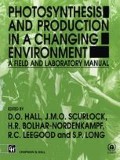Abstract
The rice cultivar I. R.8, so-called ‘miracle rice’, and its derivatives, represent one of the most significant contributions of plant physiology to the improvement of crop yields. Ву comparison to older varieties, the I.R. varieties have higher rates of crop photosynthesis achieved by selection of varieties with a canopy structure allowing more light to reach lower leaves. Indeed, modification of canopy structure can substantially improve crop yield by its influence on light interception by plants [2].
Access this chapter
Tax calculation will be finalised at checkout
Purchases are for personal use only
Preview
Unable to display preview. Download preview PDF.
References
Anderson, M.C. (1971) Radiation and crop structure. In: Plant Photosynthetic Production. Manual of Methods. (Z. Sestak, J. Catsky and P.G. Jarvis, eds.). pp. 412–466. Dr. W. Junk, The Hague, Netherlands.
Beadle, C.L., S.P. Long, S.K. Imbamba, D.O. Hall and R.J. Olembo (1985) Photosynthesis in Relation to Plant Production in Terrestrial Environments. Tycooly/Cassell, London.
Bonhomme, R. and P. Chartier (1972) The interpretation and automatic measurement of hemispherical photographs to obtain sunlit foliage area and gap frequency. Israeli J. Agricultural Research 22, 53–61.
Bonhomme, R., C. Varlet Grancher, and P. Chartier (1974) The use of hemispherical photographs for determining the leaf area index of young crops. Photosynthetica 8, 299–301.
Caldwell, M.M., T.J. Dean, R.S. Nowak, R.S. Dzurec and J.H. Richards (1983) Bunchgrass architecture, light interception, and water-use efficiency: assessment by fiber optic point quadrats and gas exchange. Oecologia 59, 178–184.
Caldwell, M.M., G.W. Harris and R.S. Dzurec (1983) A fiber optic point quadrat system for improved accuracy in vegetation sampling. Oecologia 59, 417–418.
Campbell, G.S. (1986) Extinction coefficients for radiation in plant canopies calculated using an ellipsoidal inclination angle distribution. Agricultural and Forest Meteorology 36, 317–321.
Campbell, G.S. (1990) Derivation of an angle density function for canopies with ellipsoidal leaf angle distributions. Agricultural and Forest Meteorology 49, 173–176.
Campbell, G.S., and J.M. Norman (1988) The description and measurement of plant canopy structure. In: Plant Canopies: Their Growth, Form and Function (G. Russell, B. Marshall, and P.G. Jarvis, eds.). pp. 1–19. Society for Experimental Biology, Seminar Series 29, Cambridge University Press, New York.
Duncan, W.G. (1971) Leaf angles, leaf area, and canopy photosynthesis. Crop Sci. 11, 482–485.
Ehleringer, J. and I. Forseth (1980) Solar tracking by plants. Science 210, 1094–1098.
Fuchs, M., G. Asrar, and E.T. Kanemasu (1984) Leaf area estimates from measurements of photosynthetically active radiation in wheat canopies. Agricultural and Forest Meteorology 32, 13–22.
Grant, S.A. (1981) Sward components. In: Sward Management Handbook (J. Hodgson, R.D. Baker, A. Davies, A.S. Laidlaw and J.D. Leaver, eds.). pp. 70–91. British Grassland Society, Hurley, Berkshire, U.K.
Hodánová, D. (1979) Sugar beet canopy photosynthesis as limited by leaf age and irradiance. Estimation by models. Photosynthetica 13, 376–385.
Kopec, D.M., J.M. Norman, R.C. Shearman, and M.P. Peterson (1987) An indirect method for estimating turfgrass leaf area index. Crop Sci. 27, 1298–1301.
Kvet, J. and J.K. Marshall (1971) Assessment of leaf area and other assimilating plant surfaces. In: Plant Photosynthetic Production. Manual of Methods. (Z. Sestak, J. Catsky and P.G. Jarvis, eds.). pp. 517–555. Dr. W. Junk, The Hague, Netherlands.
Lang, A.R.G., and Yueqin Xiang (1986) Estimation of leaf area index from transmission of direct sunlight in discontinuous canopies. Agricultural and Forest Meteorology 37, 229–243.
Lang, A.R.G., Yueqin Xiang and J.M. Norman (1985) Crop structure and the penetration of direct sunlight. Agricultural and Forest Meteorology 35, 83–101.
Lang, A.R.G. (1987) Simplified estimate of leaf area index from transmittance of the sun’s beam. Agricultural and Forest Meteorology 41, 179–186.
McMillen, C.G. and J.H. McClendon (1979) Leaf angle: an adaptive feature of sun and shade leaves. Bot. Gazette 140, 437–442.
Monsi, M. and T. Saeki (1953) Über den Lichtfaktor in den Pflanzengesellschaften und seine Bedeutung fur die Stoffproduktion. Japanese J. Bot. 14, 22–52.
Monsi, M., Z. Uchijima and T. Oikawa (1973) Structure of foliage canopies and photosynthesis. Ann. Rev. Ecol. System. 4, 301–327.
Nobel, P.S. (1991) Physicochemical and Environmental Plant Physiology. Academic Press, San Diego.
Norman, J.M. (1980) Interfacing leaf and canopy light interception models. In: Predicting Photosynthesis for Ecosystem Models. Vol. 2 (J.D. Hesketh and J.W. Jones, eds.). pp. 49–67. CRC Press, Boca Raton, Florida.
Norman, J.M. and G.S. Campbell (1989) Canopy structure. In: Plant Physiological Ecology. Field Methods and Instrumentation. (R.W. Pearcy, J.R. Ehleringer, H.A. Mooney and P.W. Rundel, eds.). pp. 301–325.Chapman and Hall, London, New York.
Perry, S.G., A.B. Fraser, D.W. Thomson and J.M. Norman (1988) Indirect sensing of plant canopy structure with simple radiation measurements. Agricultural and Forest Meteorology 42, 255–278.
Rhodes, I. (1981) Canopy structure. In: Sward Management Handbook (J. Hodgson, R.D. Baker, A. Davies, A.S. Laidlaw and J.D. Leaver, eds.). pp. 141–158. British Grassland Society, Hurley, Berkshire, U.K.
Ross, J. (1981) The Radiation Regime and Architecture of Plant Stands. Dr. W. Junk, The Hague, Netherlands.
Szeicz, G., J.L. Monteith and J.M. dos Santos (1964) Tube solarimeters to measure radiation among plants. J. Applied Ecology 1, 169–174.
Turitzin, S.N. and B.G. Drake (1981) The effect of a seasonal change in canopy structure on the photosynthetic efficiency of a salt marsh. Oecologia 48, 79–84.
Warren-Wilson, J. (1959) Analysis of the distribution of foliage in grassland. In: The Measurement of Grassland Productivity (J.D. Irvins, ed.). pp. 51–61. Butterworths, London.
Warren-Wilson, J. (1963) Estimation of foliage denseness and foliage angle by inclined point quadrats. Australian J. Bot. 11, 95–105.
Wit, C. T. de (1965) Photosynthesis of leaf canopies. Verslagen van Landbouwkundige Onderzoekingen No. 663. Wageningen.
Editor information
Rights and permissions
Copyright information
© 1993 Springer Science+Business Media Dordrecht
About this chapter
Cite this chapter
Nobel, P.S., Forseth, I.N., Long, S.P. (1993). Canopy structure and light interception. In: Hall, D.O., Scurlock, J.M.O., Bolhàr-Nordenkampf, H.R., Leegood, R.C., Long, S.P. (eds) Photosynthesis and Production in a Changing Environment. Springer, Dordrecht. https://doi.org/10.1007/978-94-011-1566-7_6
Download citation
DOI: https://doi.org/10.1007/978-94-011-1566-7_6
Publisher Name: Springer, Dordrecht
Print ISBN: 978-0-412-42910-1
Online ISBN: 978-94-011-1566-7
eBook Packages: Springer Book Archive

